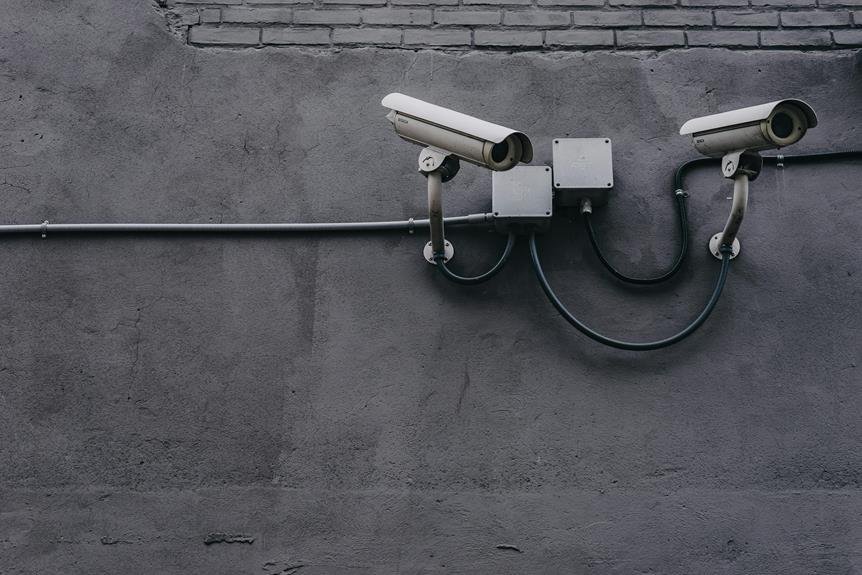
So, you're curious about how two-way audio operates within smart security cameras. Picture this – imagine being able to not only see what's happening but also interact in real-time with the environment being monitored. How does this seamless exchange of audio signals truly come to life, enabling you to communicate through a camera across distances? Let's unravel the intricate workings behind this innovative feature that elevates the functionality of modern surveillance systems.
Technology Behind Two-Way Audio
The technology behind two-way audio in smart security cameras enables real-time communication between users and their surroundings. This feature allows you to both listen to what's happening in the camera's vicinity and speak directly through the camera. When you engage in two-way audio, your voice is picked up by a microphone in the camera, transmitted over the network, and played through a speaker at the camera's location. This bidirectional flow of audio data is made possible by the integration of microphones and speakers within the camera's design.
The audio data is digitized and compressed before being transmitted, ensuring efficient communication with minimal delays. Advanced signal processing algorithms help filter out background noise, providing clear audio transmission. Additionally, secure network protocols safeguard the communication, preventing unauthorized access to the audio stream. By leveraging these technologies, smart security cameras offer a convenient way for you to interact with your surroundings, whether it's monitoring your home or communicating with visitors at the door.
Components Involved in Audio Transmission
Exploring the inner workings of audio transmission in smart security cameras reveals the intricate coordination of various components. When you speak into the camera's microphone, the sound waves are converted into electrical signals. These signals are then processed by the audio processing unit, where they're digitized and compressed to reduce file size for efficient transmission. The compressed audio data is sent over the network through the camera's built-in Wi-Fi or Ethernet connection.
At the receiving end, the audio data is received by the camera's audio receiver, where it's decompressed and converted back into an electrical signal. This signal is then sent to the camera's speaker, which reproduces the sound, allowing you to hear the audio in real-time. The components involved in audio transmission, including microphones, audio processing units, speakers, and network interfaces, work seamlessly together to enable two-way audio communication in smart security cameras.
Real-Time Communication Capabilities
Unveiling the seamless integration of two-way audio, smart security cameras offer real-time communication capabilities that enhance surveillance efficiency. This feature allows you to communicate directly with individuals on the other end of the camera in real time, enabling quick response actions when needed. Whether you're at home or remotely monitoring your property, the ability to engage in two-way communication provides an added layer of security and convenience.
With real-time communication capabilities, you can warn off potential intruders, give instructions to delivery personnel, or communicate with family members within the camera's range. The immediacy of this feature fosters a sense of control over your surroundings, making it easier to address situations as they unfold. By simply tapping into the camera feed through your device, you can speak and listen through the camera's built-in microphone and speaker, creating a seamless communication channel that enhances the overall functionality of your smart security system.
Integration With Smart Home Systems
Enhance your smart security camera's functionality by seamlessly integrating it with your smart home system. By connecting your security camera to your smart home hub or system, you can enjoy a more comprehensive and streamlined home security experience. Integration with smart home systems allows you to control your camera along with other smart devices from a centralized platform, such as a mobile app or a smart speaker.
With this integration, you can receive notifications on your smartphone when the camera detects motion or sound, and easily access the camera feed to check on your home in real-time. Moreover, you can automate actions based on the camera's activity, such as turning on lights when motion is detected or setting your smart thermostat to a specific temperature when no motion is sensed.
Additionally, integrating your smart security camera with your smart home system enables you to create customized routines and schedules, enhancing the overall security and convenience of your home. Whether you're looking to enhance security, monitor your property, or simply make daily tasks more efficient, integrating your smart security camera with your smart home system can offer you a more connected and intelligent living environment.




